Strategic Management Report: Digi Telecommunications & Toyota
VerifiedAdded on 2020/05/28
|16
|4949
|42
Report
AI Summary
This report provides a strategic management analysis of Digi Telecommunications and Toyota Global, examining their mission, vision, and business strategies. It includes a macro-environmental analysis using PESTLE and Porter's Five Forces to assess the external factors influencing each company. The report compares the strategic approaches of both firms, highlighting their responses to market challenges and opportunities. Digi Telecommunications' strategies focus on becoming a leading mobile internet provider, while Toyota emphasizes quality and innovation in the automotive industry. The analysis considers the political and economic environments, regulatory impacts, and competitive landscapes faced by both companies, offering insights into their long-term growth and sustainability.
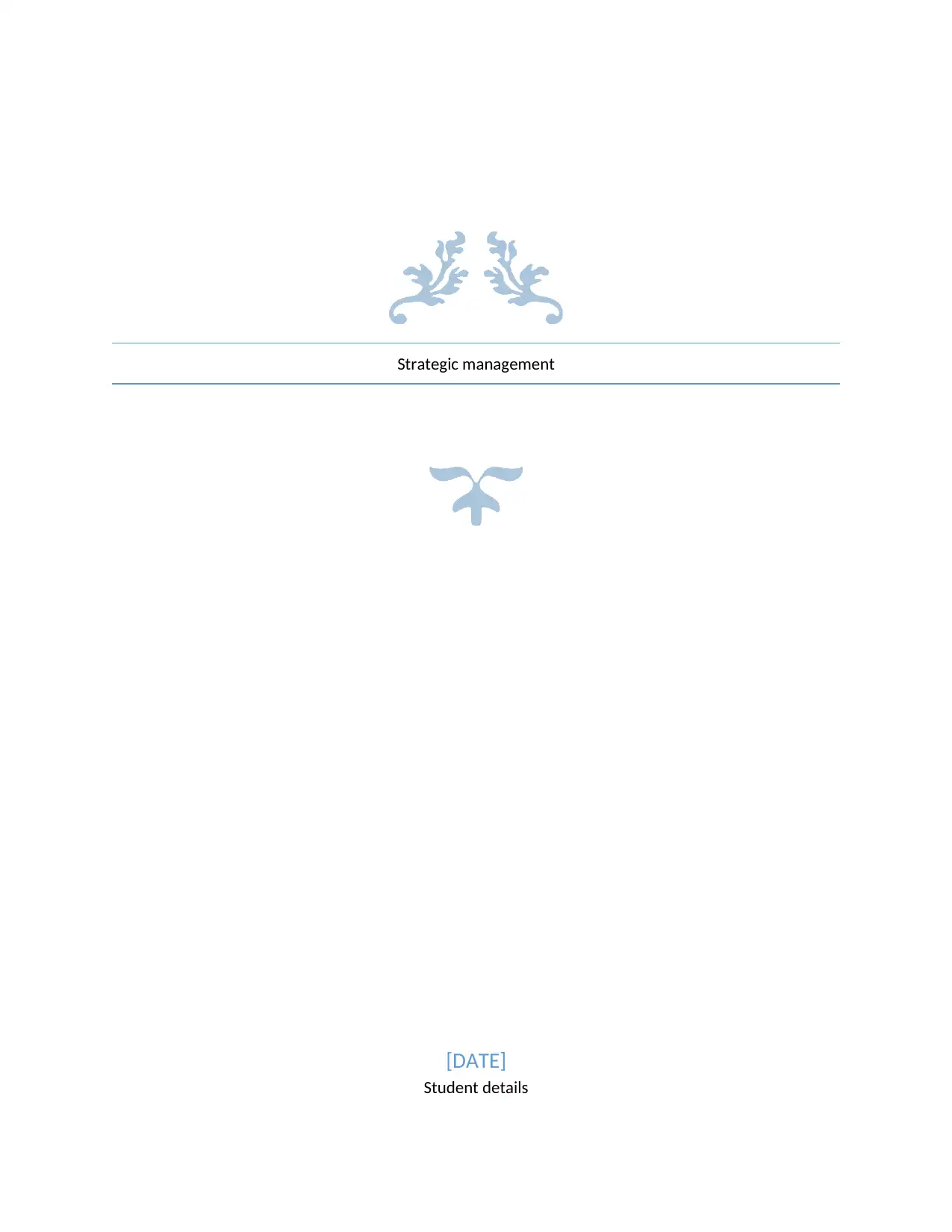
Strategic management
[DATE]
Student details
[DATE]
Student details
Paraphrase This Document
Need a fresh take? Get an instant paraphrase of this document with our AI Paraphraser
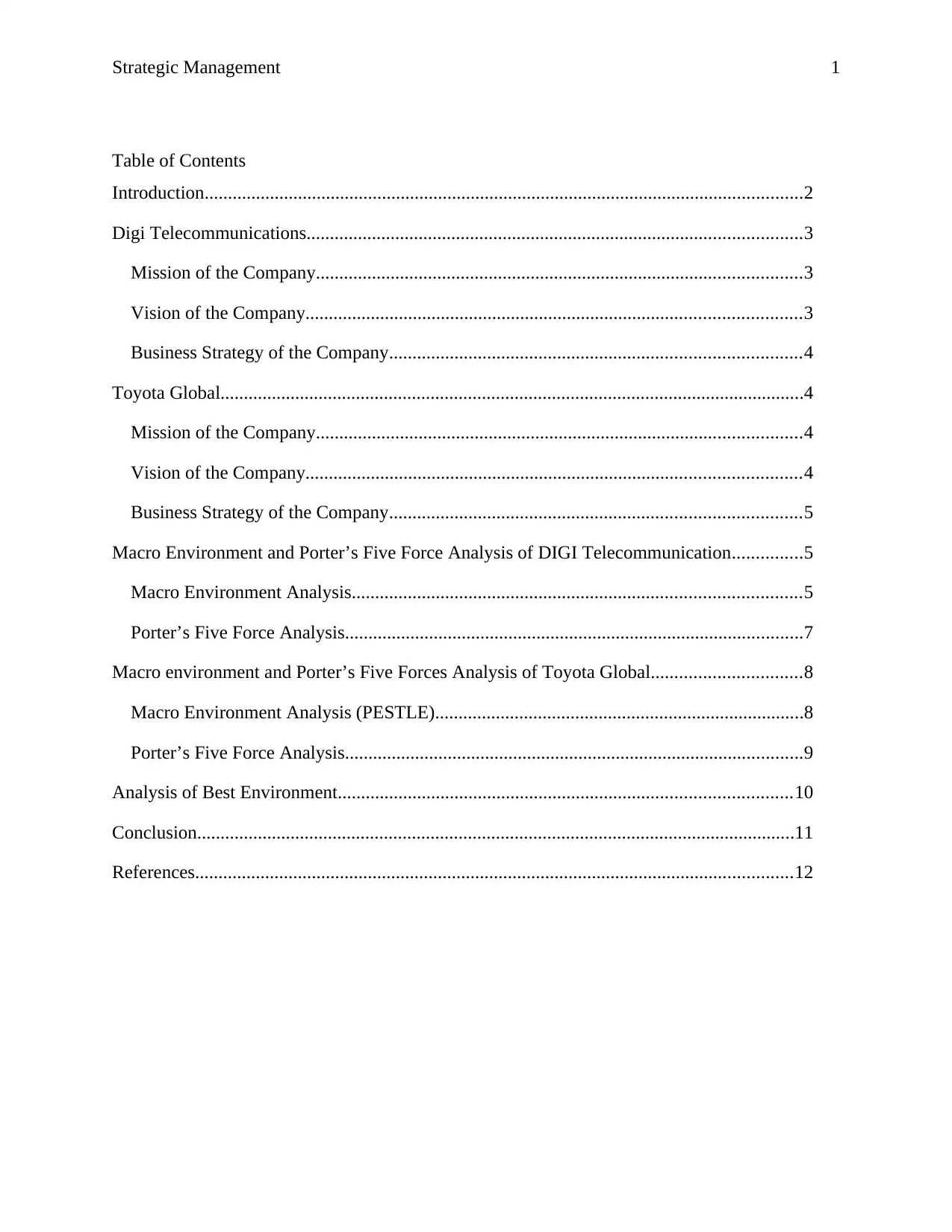
Strategic Management 1
Table of Contents
Introduction................................................................................................................................2
Digi Telecommunications..........................................................................................................3
Mission of the Company........................................................................................................3
Vision of the Company..........................................................................................................3
Business Strategy of the Company........................................................................................4
Toyota Global.............................................................................................................................4
Mission of the Company........................................................................................................4
Vision of the Company..........................................................................................................4
Business Strategy of the Company........................................................................................5
Macro Environment and Porter’s Five Force Analysis of DIGI Telecommunication...............5
Macro Environment Analysis................................................................................................5
Porter’s Five Force Analysis..................................................................................................7
Macro environment and Porter’s Five Forces Analysis of Toyota Global................................8
Macro Environment Analysis (PESTLE)...............................................................................8
Porter’s Five Force Analysis..................................................................................................9
Analysis of Best Environment.................................................................................................10
Conclusion................................................................................................................................11
References................................................................................................................................12
Table of Contents
Introduction................................................................................................................................2
Digi Telecommunications..........................................................................................................3
Mission of the Company........................................................................................................3
Vision of the Company..........................................................................................................3
Business Strategy of the Company........................................................................................4
Toyota Global.............................................................................................................................4
Mission of the Company........................................................................................................4
Vision of the Company..........................................................................................................4
Business Strategy of the Company........................................................................................5
Macro Environment and Porter’s Five Force Analysis of DIGI Telecommunication...............5
Macro Environment Analysis................................................................................................5
Porter’s Five Force Analysis..................................................................................................7
Macro environment and Porter’s Five Forces Analysis of Toyota Global................................8
Macro Environment Analysis (PESTLE)...............................................................................8
Porter’s Five Force Analysis..................................................................................................9
Analysis of Best Environment.................................................................................................10
Conclusion................................................................................................................................11
References................................................................................................................................12
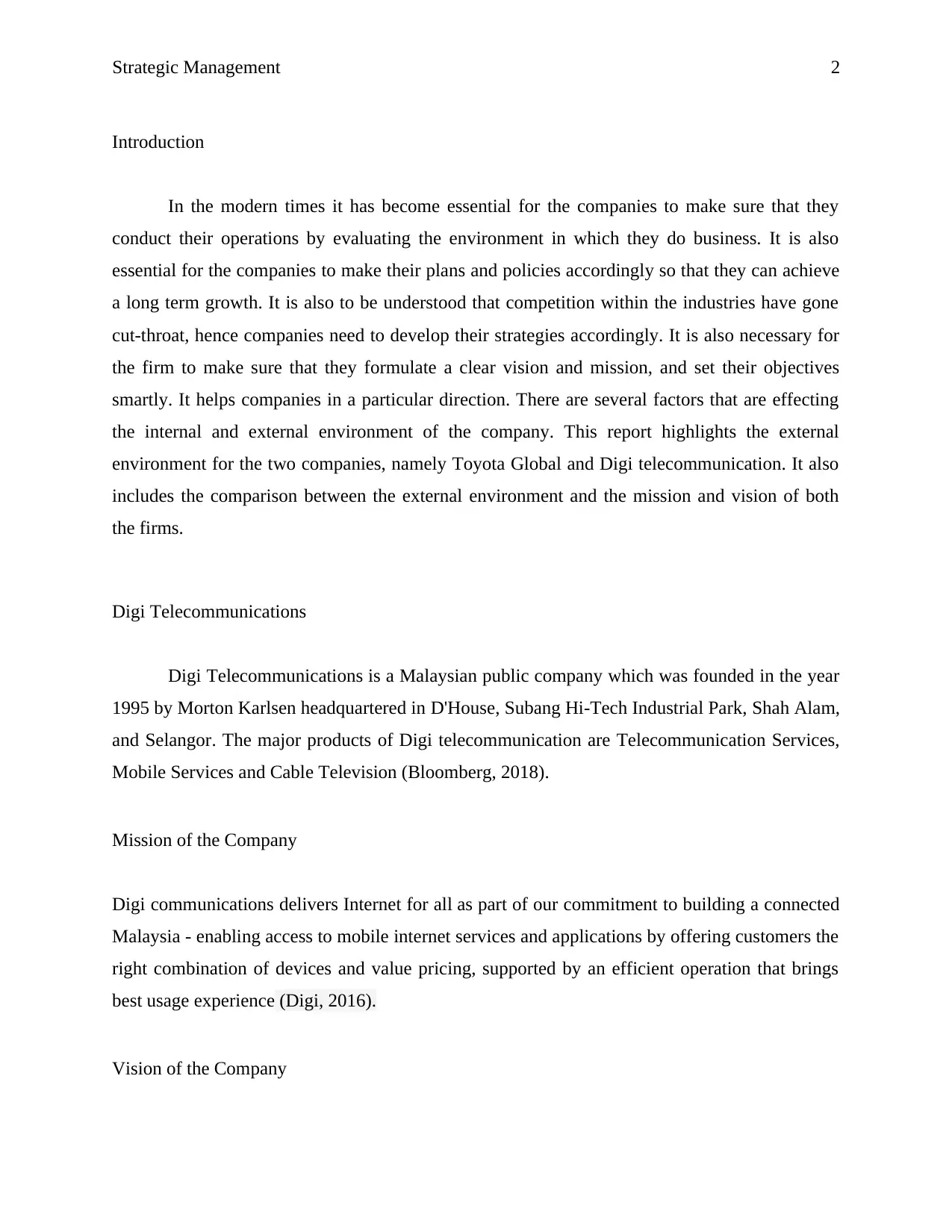
Strategic Management 2
Introduction
In the modern times it has become essential for the companies to make sure that they
conduct their operations by evaluating the environment in which they do business. It is also
essential for the companies to make their plans and policies accordingly so that they can achieve
a long term growth. It is also to be understood that competition within the industries have gone
cut-throat, hence companies need to develop their strategies accordingly. It is also necessary for
the firm to make sure that they formulate a clear vision and mission, and set their objectives
smartly. It helps companies in a particular direction. There are several factors that are effecting
the internal and external environment of the company. This report highlights the external
environment for the two companies, namely Toyota Global and Digi telecommunication. It also
includes the comparison between the external environment and the mission and vision of both
the firms.
Digi Telecommunications
Digi Telecommunications is a Malaysian public company which was founded in the year
1995 by Morton Karlsen headquartered in D'House, Subang Hi-Tech Industrial Park, Shah Alam,
and Selangor. The major products of Digi telecommunication are Telecommunication Services,
Mobile Services and Cable Television (Bloomberg, 2018).
Mission of the Company
Digi communications delivers Internet for all as part of our commitment to building a connected
Malaysia - enabling access to mobile internet services and applications by offering customers the
right combination of devices and value pricing, supported by an efficient operation that brings
best usage experience (Digi, 2016).
Vision of the Company
Introduction
In the modern times it has become essential for the companies to make sure that they
conduct their operations by evaluating the environment in which they do business. It is also
essential for the companies to make their plans and policies accordingly so that they can achieve
a long term growth. It is also to be understood that competition within the industries have gone
cut-throat, hence companies need to develop their strategies accordingly. It is also necessary for
the firm to make sure that they formulate a clear vision and mission, and set their objectives
smartly. It helps companies in a particular direction. There are several factors that are effecting
the internal and external environment of the company. This report highlights the external
environment for the two companies, namely Toyota Global and Digi telecommunication. It also
includes the comparison between the external environment and the mission and vision of both
the firms.
Digi Telecommunications
Digi Telecommunications is a Malaysian public company which was founded in the year
1995 by Morton Karlsen headquartered in D'House, Subang Hi-Tech Industrial Park, Shah Alam,
and Selangor. The major products of Digi telecommunication are Telecommunication Services,
Mobile Services and Cable Television (Bloomberg, 2018).
Mission of the Company
Digi communications delivers Internet for all as part of our commitment to building a connected
Malaysia - enabling access to mobile internet services and applications by offering customers the
right combination of devices and value pricing, supported by an efficient operation that brings
best usage experience (Digi, 2016).
Vision of the Company
⊘ This is a preview!⊘
Do you want full access?
Subscribe today to unlock all pages.

Trusted by 1+ million students worldwide
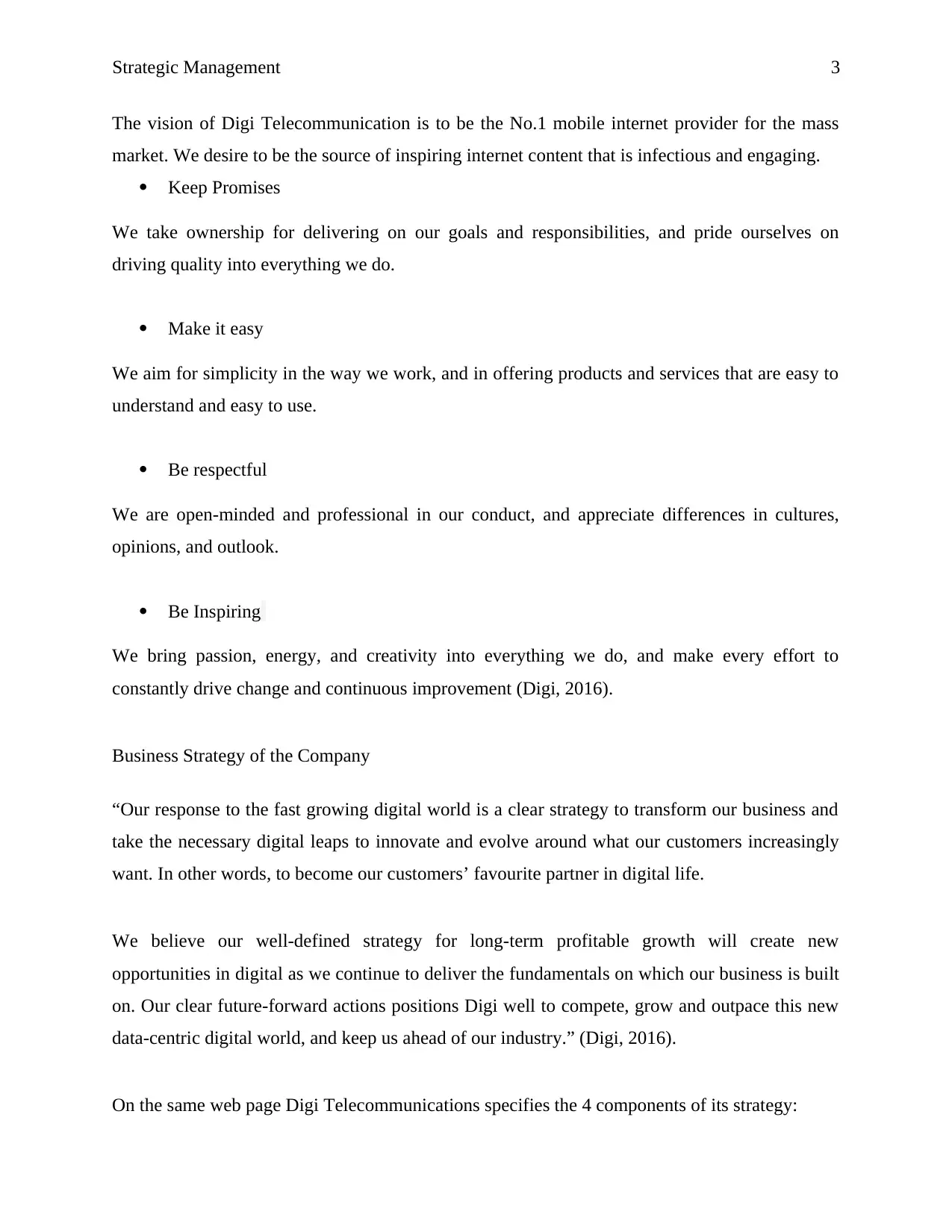
Strategic Management 3
The vision of Digi Telecommunication is to be the No.1 mobile internet provider for the mass
market. We desire to be the source of inspiring internet content that is infectious and engaging.
Keep Promises
We take ownership for delivering on our goals and responsibilities, and pride ourselves on
driving quality into everything we do.
Make it easy
We aim for simplicity in the way we work, and in offering products and services that are easy to
understand and easy to use.
Be respectful
We are open-minded and professional in our conduct, and appreciate differences in cultures,
opinions, and outlook.
Be Inspiring
We bring passion, energy, and creativity into everything we do, and make every effort to
constantly drive change and continuous improvement (Digi, 2016).
Business Strategy of the Company
“Our response to the fast growing digital world is a clear strategy to transform our business and
take the necessary digital leaps to innovate and evolve around what our customers increasingly
want. In other words, to become our customers’ favourite partner in digital life.
We believe our well-defined strategy for long-term profitable growth will create new
opportunities in digital as we continue to deliver the fundamentals on which our business is built
on. Our clear future-forward actions positions Digi well to compete, grow and outpace this new
data-centric digital world, and keep us ahead of our industry.” (Digi, 2016).
On the same web page Digi Telecommunications specifies the 4 components of its strategy:
The vision of Digi Telecommunication is to be the No.1 mobile internet provider for the mass
market. We desire to be the source of inspiring internet content that is infectious and engaging.
Keep Promises
We take ownership for delivering on our goals and responsibilities, and pride ourselves on
driving quality into everything we do.
Make it easy
We aim for simplicity in the way we work, and in offering products and services that are easy to
understand and easy to use.
Be respectful
We are open-minded and professional in our conduct, and appreciate differences in cultures,
opinions, and outlook.
Be Inspiring
We bring passion, energy, and creativity into everything we do, and make every effort to
constantly drive change and continuous improvement (Digi, 2016).
Business Strategy of the Company
“Our response to the fast growing digital world is a clear strategy to transform our business and
take the necessary digital leaps to innovate and evolve around what our customers increasingly
want. In other words, to become our customers’ favourite partner in digital life.
We believe our well-defined strategy for long-term profitable growth will create new
opportunities in digital as we continue to deliver the fundamentals on which our business is built
on. Our clear future-forward actions positions Digi well to compete, grow and outpace this new
data-centric digital world, and keep us ahead of our industry.” (Digi, 2016).
On the same web page Digi Telecommunications specifies the 4 components of its strategy:
Paraphrase This Document
Need a fresh take? Get an instant paraphrase of this document with our AI Paraphraser
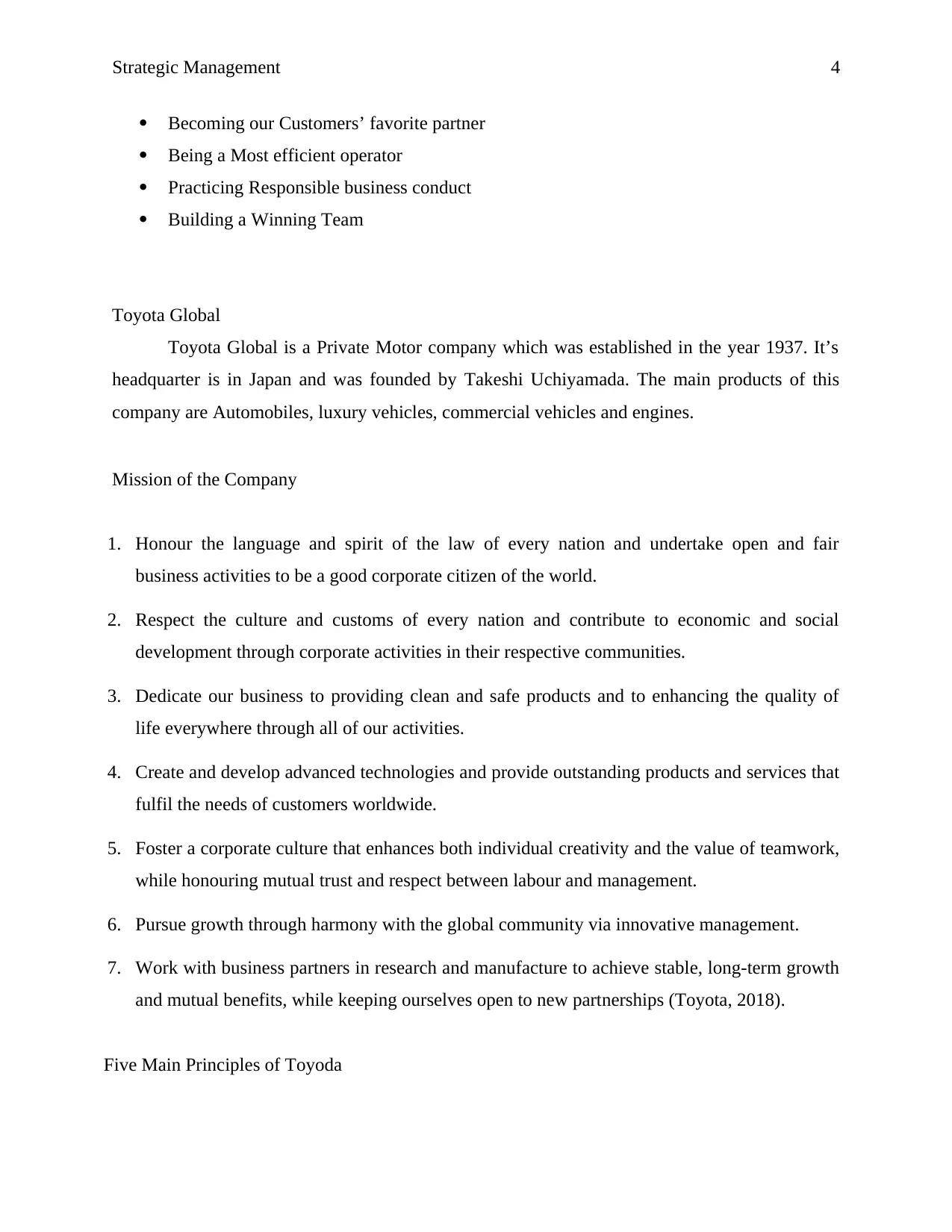
Strategic Management 4
Becoming our Customers’ favorite partner
Being a Most efficient operator
Practicing Responsible business conduct
Building a Winning Team
Toyota Global
Toyota Global is a Private Motor company which was established in the year 1937. It’s
headquarter is in Japan and was founded by Takeshi Uchiyamada. The main products of this
company are Automobiles, luxury vehicles, commercial vehicles and engines.
Mission of the Company
1. Honour the language and spirit of the law of every nation and undertake open and fair
business activities to be a good corporate citizen of the world.
2. Respect the culture and customs of every nation and contribute to economic and social
development through corporate activities in their respective communities.
3. Dedicate our business to providing clean and safe products and to enhancing the quality of
life everywhere through all of our activities.
4. Create and develop advanced technologies and provide outstanding products and services that
fulfil the needs of customers worldwide.
5. Foster a corporate culture that enhances both individual creativity and the value of teamwork,
while honouring mutual trust and respect between labour and management.
6. Pursue growth through harmony with the global community via innovative management.
7. Work with business partners in research and manufacture to achieve stable, long-term growth
and mutual benefits, while keeping ourselves open to new partnerships (Toyota, 2018).
Five Main Principles of Toyoda
Becoming our Customers’ favorite partner
Being a Most efficient operator
Practicing Responsible business conduct
Building a Winning Team
Toyota Global
Toyota Global is a Private Motor company which was established in the year 1937. It’s
headquarter is in Japan and was founded by Takeshi Uchiyamada. The main products of this
company are Automobiles, luxury vehicles, commercial vehicles and engines.
Mission of the Company
1. Honour the language and spirit of the law of every nation and undertake open and fair
business activities to be a good corporate citizen of the world.
2. Respect the culture and customs of every nation and contribute to economic and social
development through corporate activities in their respective communities.
3. Dedicate our business to providing clean and safe products and to enhancing the quality of
life everywhere through all of our activities.
4. Create and develop advanced technologies and provide outstanding products and services that
fulfil the needs of customers worldwide.
5. Foster a corporate culture that enhances both individual creativity and the value of teamwork,
while honouring mutual trust and respect between labour and management.
6. Pursue growth through harmony with the global community via innovative management.
7. Work with business partners in research and manufacture to achieve stable, long-term growth
and mutual benefits, while keeping ourselves open to new partnerships (Toyota, 2018).
Five Main Principles of Toyoda
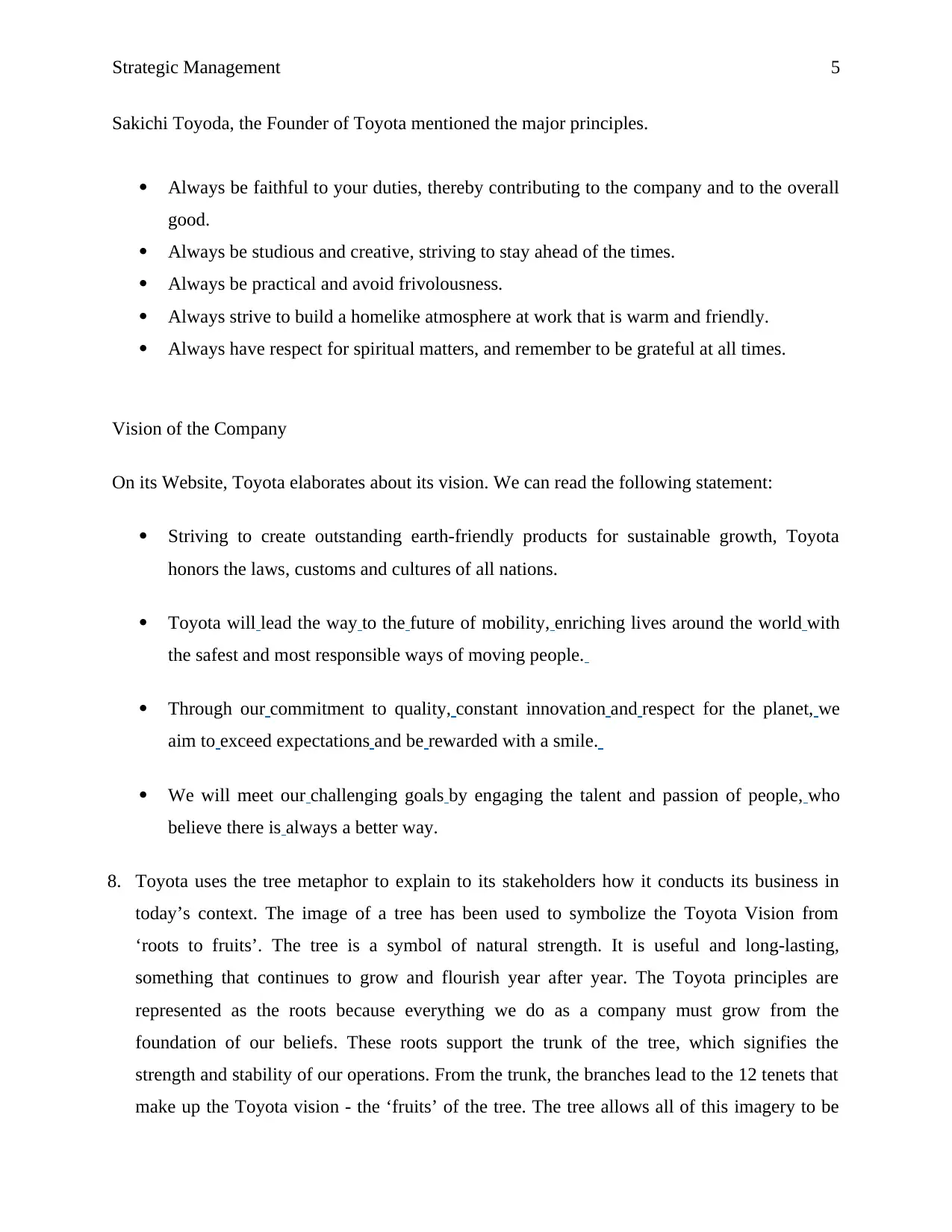
Strategic Management 5
Sakichi Toyoda, the Founder of Toyota mentioned the major principles.
Always be faithful to your duties, thereby contributing to the company and to the overall
good.
Always be studious and creative, striving to stay ahead of the times.
Always be practical and avoid frivolousness.
Always strive to build a homelike atmosphere at work that is warm and friendly.
Always have respect for spiritual matters, and remember to be grateful at all times.
Vision of the Company
On its Website, Toyota elaborates about its vision. We can read the following statement:
Striving to create outstanding earth-friendly products for sustainable growth, Toyota
honors the laws, customs and cultures of all nations.
Toyota will lead the way to the future of mobility, enriching lives around the world with
the safest and most responsible ways of moving people.
Through our commitment to quality, constant innovation and respect for the planet, we
aim to exceed expectations and be rewarded with a smile.
We will meet our challenging goals by engaging the talent and passion of people, who
believe there is always a better way.
8. Toyota uses the tree metaphor to explain to its stakeholders how it conducts its business in
today’s context. The image of a tree has been used to symbolize the Toyota Vision from
‘roots to fruits’. The tree is a symbol of natural strength. It is useful and long-lasting,
something that continues to grow and flourish year after year. The Toyota principles are
represented as the roots because everything we do as a company must grow from the
foundation of our beliefs. These roots support the trunk of the tree, which signifies the
strength and stability of our operations. From the trunk, the branches lead to the 12 tenets that
make up the Toyota vision - the ‘fruits’ of the tree. The tree allows all of this imagery to be
Sakichi Toyoda, the Founder of Toyota mentioned the major principles.
Always be faithful to your duties, thereby contributing to the company and to the overall
good.
Always be studious and creative, striving to stay ahead of the times.
Always be practical and avoid frivolousness.
Always strive to build a homelike atmosphere at work that is warm and friendly.
Always have respect for spiritual matters, and remember to be grateful at all times.
Vision of the Company
On its Website, Toyota elaborates about its vision. We can read the following statement:
Striving to create outstanding earth-friendly products for sustainable growth, Toyota
honors the laws, customs and cultures of all nations.
Toyota will lead the way to the future of mobility, enriching lives around the world with
the safest and most responsible ways of moving people.
Through our commitment to quality, constant innovation and respect for the planet, we
aim to exceed expectations and be rewarded with a smile.
We will meet our challenging goals by engaging the talent and passion of people, who
believe there is always a better way.
8. Toyota uses the tree metaphor to explain to its stakeholders how it conducts its business in
today’s context. The image of a tree has been used to symbolize the Toyota Vision from
‘roots to fruits’. The tree is a symbol of natural strength. It is useful and long-lasting,
something that continues to grow and flourish year after year. The Toyota principles are
represented as the roots because everything we do as a company must grow from the
foundation of our beliefs. These roots support the trunk of the tree, which signifies the
strength and stability of our operations. From the trunk, the branches lead to the 12 tenets that
make up the Toyota vision - the ‘fruits’ of the tree. The tree allows all of this imagery to be
⊘ This is a preview!⊘
Do you want full access?
Subscribe today to unlock all pages.

Trusted by 1+ million students worldwide
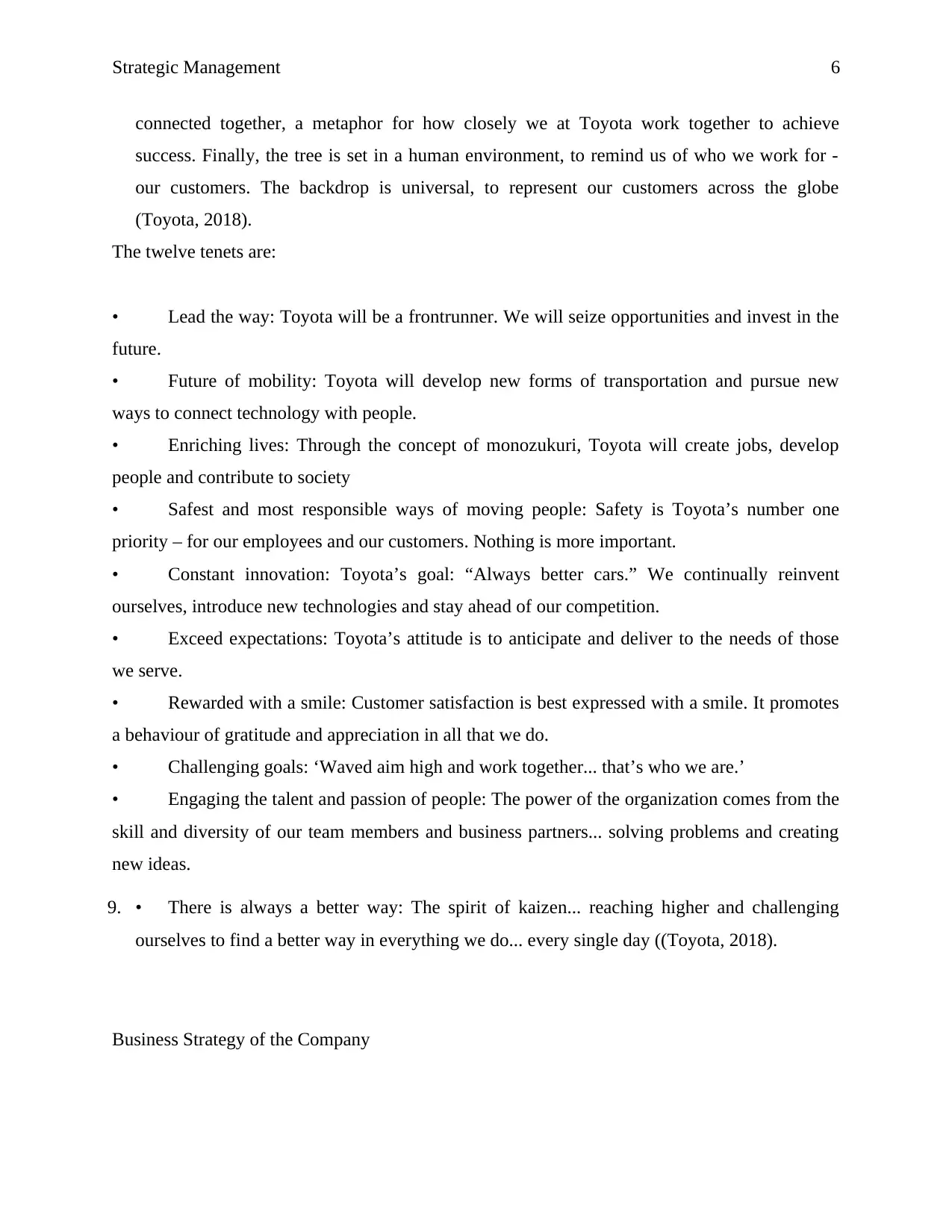
Strategic Management 6
connected together, a metaphor for how closely we at Toyota work together to achieve
success. Finally, the tree is set in a human environment, to remind us of who we work for -
our customers. The backdrop is universal, to represent our customers across the globe
(Toyota, 2018).
The twelve tenets are:
• Lead the way: Toyota will be a frontrunner. We will seize opportunities and invest in the
future.
• Future of mobility: Toyota will develop new forms of transportation and pursue new
ways to connect technology with people.
• Enriching lives: Through the concept of monozukuri, Toyota will create jobs, develop
people and contribute to society
• Safest and most responsible ways of moving people: Safety is Toyota’s number one
priority – for our employees and our customers. Nothing is more important.
• Constant innovation: Toyota’s goal: “Always better cars.” We continually reinvent
ourselves, introduce new technologies and stay ahead of our competition.
• Exceed expectations: Toyota’s attitude is to anticipate and deliver to the needs of those
we serve.
• Rewarded with a smile: Customer satisfaction is best expressed with a smile. It promotes
a behaviour of gratitude and appreciation in all that we do.
• Challenging goals: ‘Waved aim high and work together... that’s who we are.’
• Engaging the talent and passion of people: The power of the organization comes from the
skill and diversity of our team members and business partners... solving problems and creating
new ideas.
9. • There is always a better way: The spirit of kaizen... reaching higher and challenging
ourselves to find a better way in everything we do... every single day ((Toyota, 2018).
Business Strategy of the Company
connected together, a metaphor for how closely we at Toyota work together to achieve
success. Finally, the tree is set in a human environment, to remind us of who we work for -
our customers. The backdrop is universal, to represent our customers across the globe
(Toyota, 2018).
The twelve tenets are:
• Lead the way: Toyota will be a frontrunner. We will seize opportunities and invest in the
future.
• Future of mobility: Toyota will develop new forms of transportation and pursue new
ways to connect technology with people.
• Enriching lives: Through the concept of monozukuri, Toyota will create jobs, develop
people and contribute to society
• Safest and most responsible ways of moving people: Safety is Toyota’s number one
priority – for our employees and our customers. Nothing is more important.
• Constant innovation: Toyota’s goal: “Always better cars.” We continually reinvent
ourselves, introduce new technologies and stay ahead of our competition.
• Exceed expectations: Toyota’s attitude is to anticipate and deliver to the needs of those
we serve.
• Rewarded with a smile: Customer satisfaction is best expressed with a smile. It promotes
a behaviour of gratitude and appreciation in all that we do.
• Challenging goals: ‘Waved aim high and work together... that’s who we are.’
• Engaging the talent and passion of people: The power of the organization comes from the
skill and diversity of our team members and business partners... solving problems and creating
new ideas.
9. • There is always a better way: The spirit of kaizen... reaching higher and challenging
ourselves to find a better way in everything we do... every single day ((Toyota, 2018).
Business Strategy of the Company
Paraphrase This Document
Need a fresh take? Get an instant paraphrase of this document with our AI Paraphraser
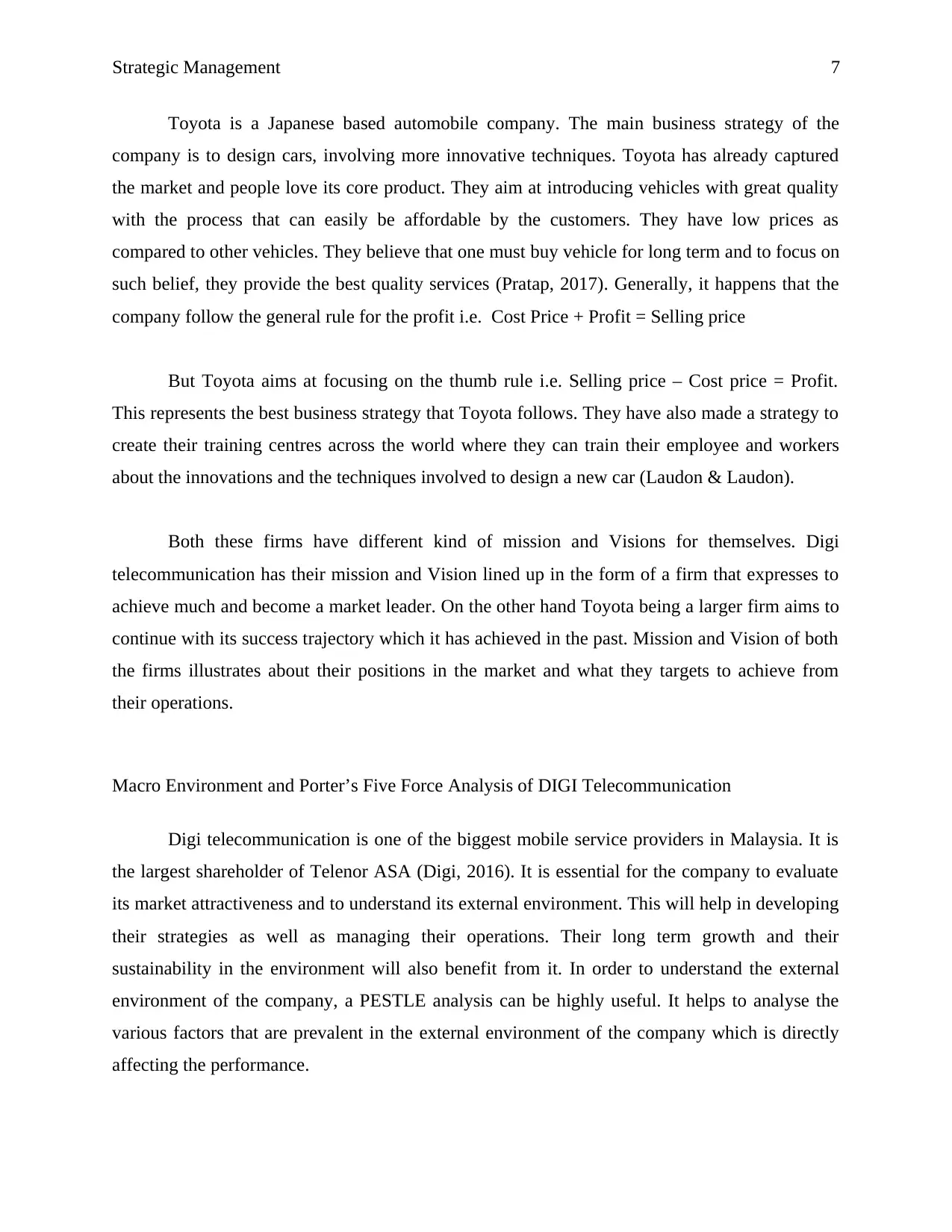
Strategic Management 7
Toyota is a Japanese based automobile company. The main business strategy of the
company is to design cars, involving more innovative techniques. Toyota has already captured
the market and people love its core product. They aim at introducing vehicles with great quality
with the process that can easily be affordable by the customers. They have low prices as
compared to other vehicles. They believe that one must buy vehicle for long term and to focus on
such belief, they provide the best quality services (Pratap, 2017). Generally, it happens that the
company follow the general rule for the profit i.e. Cost Price + Profit = Selling price
But Toyota aims at focusing on the thumb rule i.e. Selling price – Cost price = Profit.
This represents the best business strategy that Toyota follows. They have also made a strategy to
create their training centres across the world where they can train their employee and workers
about the innovations and the techniques involved to design a new car (Laudon & Laudon).
Both these firms have different kind of mission and Visions for themselves. Digi
telecommunication has their mission and Vision lined up in the form of a firm that expresses to
achieve much and become a market leader. On the other hand Toyota being a larger firm aims to
continue with its success trajectory which it has achieved in the past. Mission and Vision of both
the firms illustrates about their positions in the market and what they targets to achieve from
their operations.
Macro Environment and Porter’s Five Force Analysis of DIGI Telecommunication
Digi telecommunication is one of the biggest mobile service providers in Malaysia. It is
the largest shareholder of Telenor ASA (Digi, 2016). It is essential for the company to evaluate
its market attractiveness and to understand its external environment. This will help in developing
their strategies as well as managing their operations. Their long term growth and their
sustainability in the environment will also benefit from it. In order to understand the external
environment of the company, a PESTLE analysis can be highly useful. It helps to analyse the
various factors that are prevalent in the external environment of the company which is directly
affecting the performance.
Toyota is a Japanese based automobile company. The main business strategy of the
company is to design cars, involving more innovative techniques. Toyota has already captured
the market and people love its core product. They aim at introducing vehicles with great quality
with the process that can easily be affordable by the customers. They have low prices as
compared to other vehicles. They believe that one must buy vehicle for long term and to focus on
such belief, they provide the best quality services (Pratap, 2017). Generally, it happens that the
company follow the general rule for the profit i.e. Cost Price + Profit = Selling price
But Toyota aims at focusing on the thumb rule i.e. Selling price – Cost price = Profit.
This represents the best business strategy that Toyota follows. They have also made a strategy to
create their training centres across the world where they can train their employee and workers
about the innovations and the techniques involved to design a new car (Laudon & Laudon).
Both these firms have different kind of mission and Visions for themselves. Digi
telecommunication has their mission and Vision lined up in the form of a firm that expresses to
achieve much and become a market leader. On the other hand Toyota being a larger firm aims to
continue with its success trajectory which it has achieved in the past. Mission and Vision of both
the firms illustrates about their positions in the market and what they targets to achieve from
their operations.
Macro Environment and Porter’s Five Force Analysis of DIGI Telecommunication
Digi telecommunication is one of the biggest mobile service providers in Malaysia. It is
the largest shareholder of Telenor ASA (Digi, 2016). It is essential for the company to evaluate
its market attractiveness and to understand its external environment. This will help in developing
their strategies as well as managing their operations. Their long term growth and their
sustainability in the environment will also benefit from it. In order to understand the external
environment of the company, a PESTLE analysis can be highly useful. It helps to analyse the
various factors that are prevalent in the external environment of the company which is directly
affecting the performance.
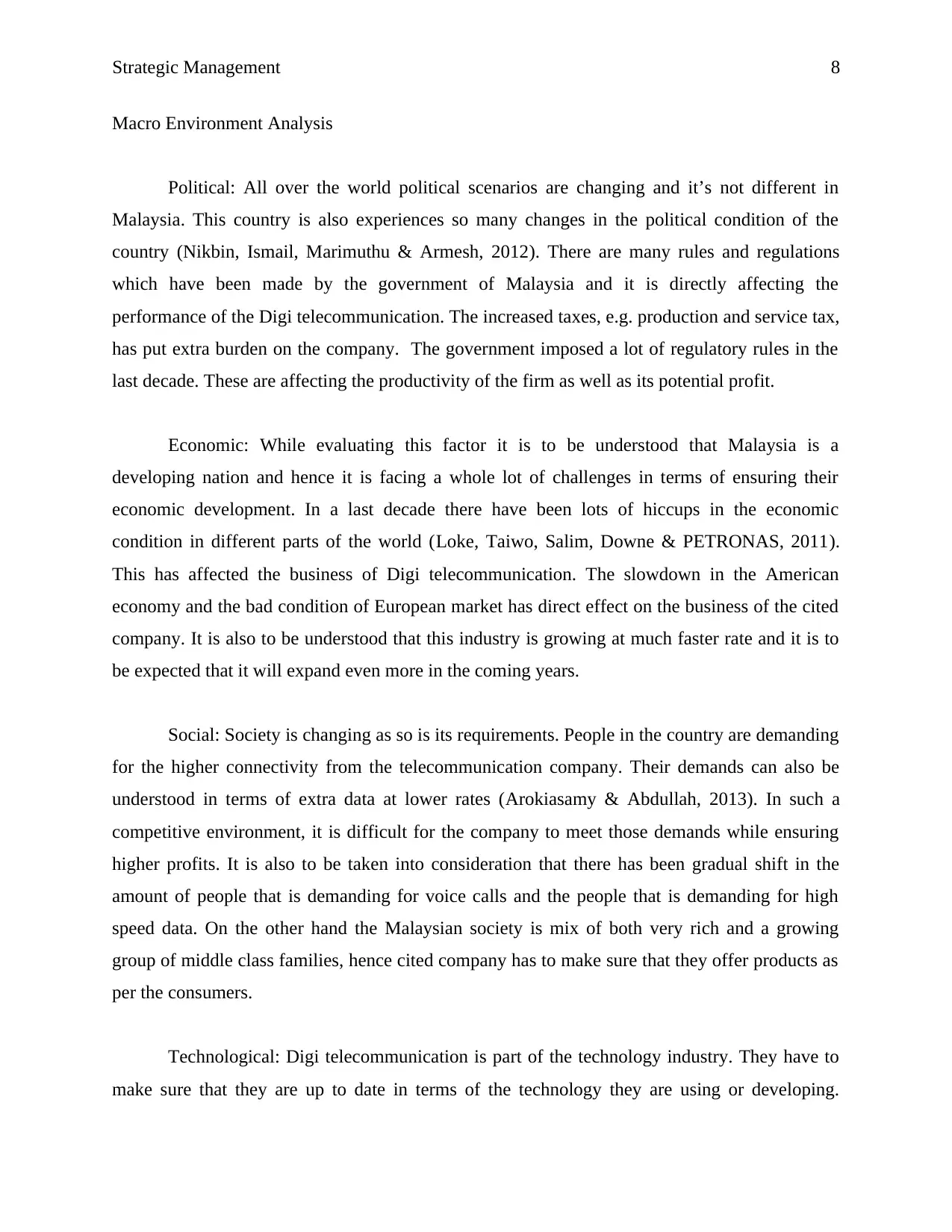
Strategic Management 8
Macro Environment Analysis
Political: All over the world political scenarios are changing and it’s not different in
Malaysia. This country is also experiences so many changes in the political condition of the
country (Nikbin, Ismail, Marimuthu & Armesh, 2012). There are many rules and regulations
which have been made by the government of Malaysia and it is directly affecting the
performance of the Digi telecommunication. The increased taxes, e.g. production and service tax,
has put extra burden on the company. The government imposed a lot of regulatory rules in the
last decade. These are affecting the productivity of the firm as well as its potential profit.
Economic: While evaluating this factor it is to be understood that Malaysia is a
developing nation and hence it is facing a whole lot of challenges in terms of ensuring their
economic development. In a last decade there have been lots of hiccups in the economic
condition in different parts of the world (Loke, Taiwo, Salim, Downe & PETRONAS, 2011).
This has affected the business of Digi telecommunication. The slowdown in the American
economy and the bad condition of European market has direct effect on the business of the cited
company. It is also to be understood that this industry is growing at much faster rate and it is to
be expected that it will expand even more in the coming years.
Social: Society is changing as so is its requirements. People in the country are demanding
for the higher connectivity from the telecommunication company. Their demands can also be
understood in terms of extra data at lower rates (Arokiasamy & Abdullah, 2013). In such a
competitive environment, it is difficult for the company to meet those demands while ensuring
higher profits. It is also to be taken into consideration that there has been gradual shift in the
amount of people that is demanding for voice calls and the people that is demanding for high
speed data. On the other hand the Malaysian society is mix of both very rich and a growing
group of middle class families, hence cited company has to make sure that they offer products as
per the consumers.
Technological: Digi telecommunication is part of the technology industry. They have to
make sure that they are up to date in terms of the technology they are using or developing.
Macro Environment Analysis
Political: All over the world political scenarios are changing and it’s not different in
Malaysia. This country is also experiences so many changes in the political condition of the
country (Nikbin, Ismail, Marimuthu & Armesh, 2012). There are many rules and regulations
which have been made by the government of Malaysia and it is directly affecting the
performance of the Digi telecommunication. The increased taxes, e.g. production and service tax,
has put extra burden on the company. The government imposed a lot of regulatory rules in the
last decade. These are affecting the productivity of the firm as well as its potential profit.
Economic: While evaluating this factor it is to be understood that Malaysia is a
developing nation and hence it is facing a whole lot of challenges in terms of ensuring their
economic development. In a last decade there have been lots of hiccups in the economic
condition in different parts of the world (Loke, Taiwo, Salim, Downe & PETRONAS, 2011).
This has affected the business of Digi telecommunication. The slowdown in the American
economy and the bad condition of European market has direct effect on the business of the cited
company. It is also to be understood that this industry is growing at much faster rate and it is to
be expected that it will expand even more in the coming years.
Social: Society is changing as so is its requirements. People in the country are demanding
for the higher connectivity from the telecommunication company. Their demands can also be
understood in terms of extra data at lower rates (Arokiasamy & Abdullah, 2013). In such a
competitive environment, it is difficult for the company to meet those demands while ensuring
higher profits. It is also to be taken into consideration that there has been gradual shift in the
amount of people that is demanding for voice calls and the people that is demanding for high
speed data. On the other hand the Malaysian society is mix of both very rich and a growing
group of middle class families, hence cited company has to make sure that they offer products as
per the consumers.
Technological: Digi telecommunication is part of the technology industry. They have to
make sure that they are up to date in terms of the technology they are using or developing.
⊘ This is a preview!⊘
Do you want full access?
Subscribe today to unlock all pages.

Trusted by 1+ million students worldwide
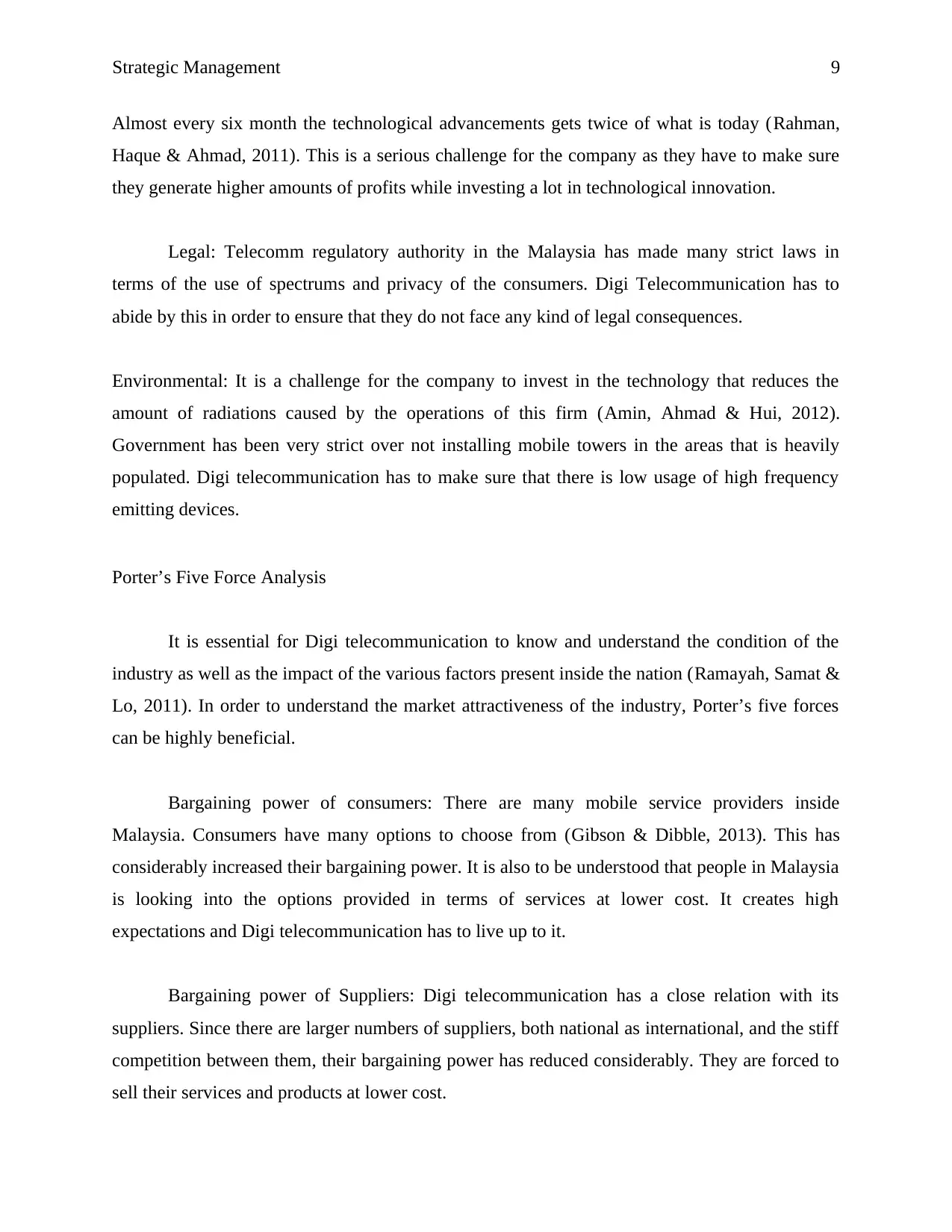
Strategic Management 9
Almost every six month the technological advancements gets twice of what is today (Rahman,
Haque & Ahmad, 2011). This is a serious challenge for the company as they have to make sure
they generate higher amounts of profits while investing a lot in technological innovation.
Legal: Telecomm regulatory authority in the Malaysia has made many strict laws in
terms of the use of spectrums and privacy of the consumers. Digi Telecommunication has to
abide by this in order to ensure that they do not face any kind of legal consequences.
Environmental: It is a challenge for the company to invest in the technology that reduces the
amount of radiations caused by the operations of this firm (Amin, Ahmad & Hui, 2012).
Government has been very strict over not installing mobile towers in the areas that is heavily
populated. Digi telecommunication has to make sure that there is low usage of high frequency
emitting devices.
Porter’s Five Force Analysis
It is essential for Digi telecommunication to know and understand the condition of the
industry as well as the impact of the various factors present inside the nation (Ramayah, Samat &
Lo, 2011). In order to understand the market attractiveness of the industry, Porter’s five forces
can be highly beneficial.
Bargaining power of consumers: There are many mobile service providers inside
Malaysia. Consumers have many options to choose from (Gibson & Dibble, 2013). This has
considerably increased their bargaining power. It is also to be understood that people in Malaysia
is looking into the options provided in terms of services at lower cost. It creates high
expectations and Digi telecommunication has to live up to it.
Bargaining power of Suppliers: Digi telecommunication has a close relation with its
suppliers. Since there are larger numbers of suppliers, both national as international, and the stiff
competition between them, their bargaining power has reduced considerably. They are forced to
sell their services and products at lower cost.
Almost every six month the technological advancements gets twice of what is today (Rahman,
Haque & Ahmad, 2011). This is a serious challenge for the company as they have to make sure
they generate higher amounts of profits while investing a lot in technological innovation.
Legal: Telecomm regulatory authority in the Malaysia has made many strict laws in
terms of the use of spectrums and privacy of the consumers. Digi Telecommunication has to
abide by this in order to ensure that they do not face any kind of legal consequences.
Environmental: It is a challenge for the company to invest in the technology that reduces the
amount of radiations caused by the operations of this firm (Amin, Ahmad & Hui, 2012).
Government has been very strict over not installing mobile towers in the areas that is heavily
populated. Digi telecommunication has to make sure that there is low usage of high frequency
emitting devices.
Porter’s Five Force Analysis
It is essential for Digi telecommunication to know and understand the condition of the
industry as well as the impact of the various factors present inside the nation (Ramayah, Samat &
Lo, 2011). In order to understand the market attractiveness of the industry, Porter’s five forces
can be highly beneficial.
Bargaining power of consumers: There are many mobile service providers inside
Malaysia. Consumers have many options to choose from (Gibson & Dibble, 2013). This has
considerably increased their bargaining power. It is also to be understood that people in Malaysia
is looking into the options provided in terms of services at lower cost. It creates high
expectations and Digi telecommunication has to live up to it.
Bargaining power of Suppliers: Digi telecommunication has a close relation with its
suppliers. Since there are larger numbers of suppliers, both national as international, and the stiff
competition between them, their bargaining power has reduced considerably. They are forced to
sell their services and products at lower cost.
Paraphrase This Document
Need a fresh take? Get an instant paraphrase of this document with our AI Paraphraser
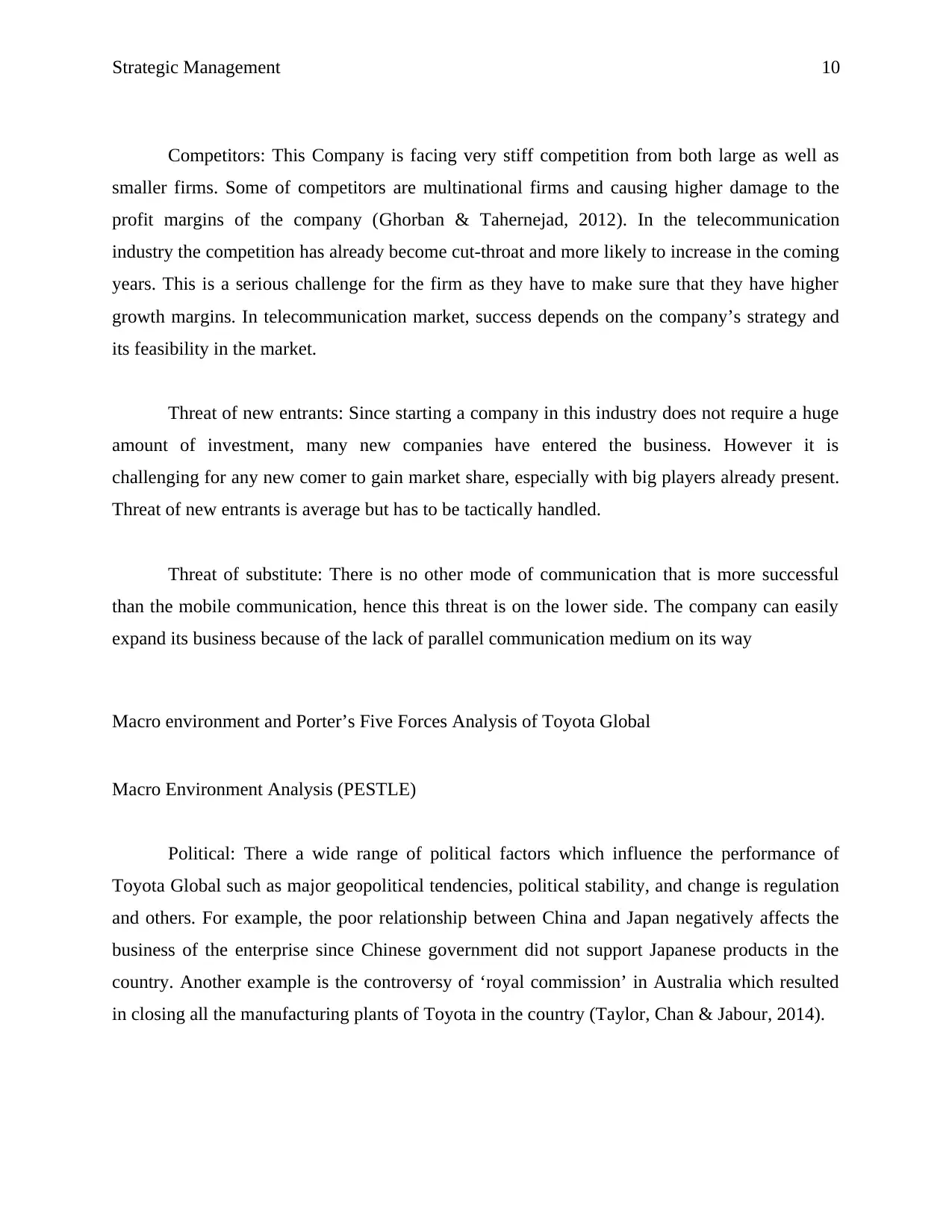
Strategic Management 10
Competitors: This Company is facing very stiff competition from both large as well as
smaller firms. Some of competitors are multinational firms and causing higher damage to the
profit margins of the company (Ghorban & Tahernejad, 2012). In the telecommunication
industry the competition has already become cut-throat and more likely to increase in the coming
years. This is a serious challenge for the firm as they have to make sure that they have higher
growth margins. In telecommunication market, success depends on the company’s strategy and
its feasibility in the market.
Threat of new entrants: Since starting a company in this industry does not require a huge
amount of investment, many new companies have entered the business. However it is
challenging for any new comer to gain market share, especially with big players already present.
Threat of new entrants is average but has to be tactically handled.
Threat of substitute: There is no other mode of communication that is more successful
than the mobile communication, hence this threat is on the lower side. The company can easily
expand its business because of the lack of parallel communication medium on its way
Macro environment and Porter’s Five Forces Analysis of Toyota Global
Macro Environment Analysis (PESTLE)
Political: There a wide range of political factors which influence the performance of
Toyota Global such as major geopolitical tendencies, political stability, and change is regulation
and others. For example, the poor relationship between China and Japan negatively affects the
business of the enterprise since Chinese government did not support Japanese products in the
country. Another example is the controversy of ‘royal commission’ in Australia which resulted
in closing all the manufacturing plants of Toyota in the country (Taylor, Chan & Jabour, 2014).
Competitors: This Company is facing very stiff competition from both large as well as
smaller firms. Some of competitors are multinational firms and causing higher damage to the
profit margins of the company (Ghorban & Tahernejad, 2012). In the telecommunication
industry the competition has already become cut-throat and more likely to increase in the coming
years. This is a serious challenge for the firm as they have to make sure that they have higher
growth margins. In telecommunication market, success depends on the company’s strategy and
its feasibility in the market.
Threat of new entrants: Since starting a company in this industry does not require a huge
amount of investment, many new companies have entered the business. However it is
challenging for any new comer to gain market share, especially with big players already present.
Threat of new entrants is average but has to be tactically handled.
Threat of substitute: There is no other mode of communication that is more successful
than the mobile communication, hence this threat is on the lower side. The company can easily
expand its business because of the lack of parallel communication medium on its way
Macro environment and Porter’s Five Forces Analysis of Toyota Global
Macro Environment Analysis (PESTLE)
Political: There a wide range of political factors which influence the performance of
Toyota Global such as major geopolitical tendencies, political stability, and change is regulation
and others. For example, the poor relationship between China and Japan negatively affects the
business of the enterprise since Chinese government did not support Japanese products in the
country. Another example is the controversy of ‘royal commission’ in Australia which resulted
in closing all the manufacturing plants of Toyota in the country (Taylor, Chan & Jabour, 2014).
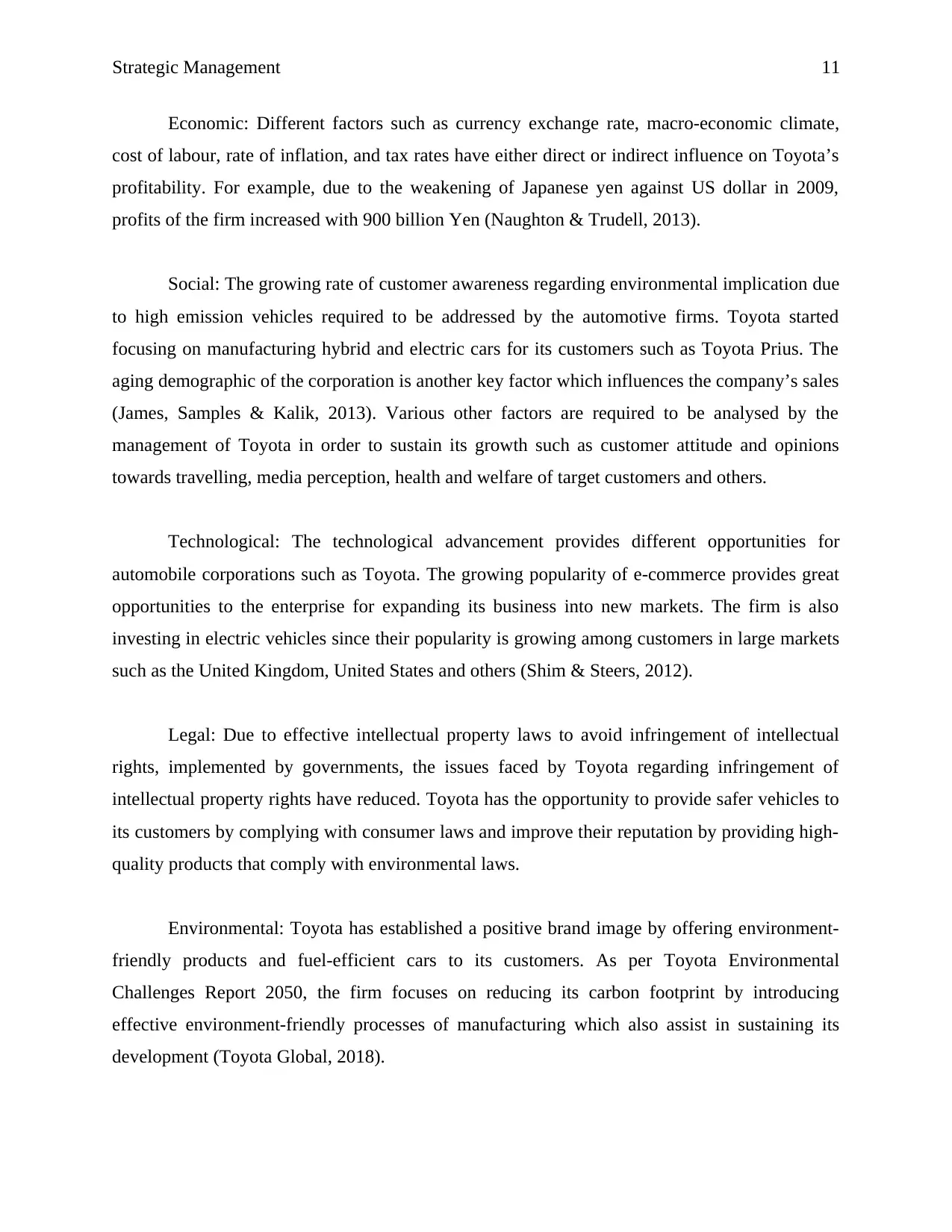
Strategic Management 11
Economic: Different factors such as currency exchange rate, macro-economic climate,
cost of labour, rate of inflation, and tax rates have either direct or indirect influence on Toyota’s
profitability. For example, due to the weakening of Japanese yen against US dollar in 2009,
profits of the firm increased with 900 billion Yen (Naughton & Trudell, 2013).
Social: The growing rate of customer awareness regarding environmental implication due
to high emission vehicles required to be addressed by the automotive firms. Toyota started
focusing on manufacturing hybrid and electric cars for its customers such as Toyota Prius. The
aging demographic of the corporation is another key factor which influences the company’s sales
(James, Samples & Kalik, 2013). Various other factors are required to be analysed by the
management of Toyota in order to sustain its growth such as customer attitude and opinions
towards travelling, media perception, health and welfare of target customers and others.
Technological: The technological advancement provides different opportunities for
automobile corporations such as Toyota. The growing popularity of e-commerce provides great
opportunities to the enterprise for expanding its business into new markets. The firm is also
investing in electric vehicles since their popularity is growing among customers in large markets
such as the United Kingdom, United States and others (Shim & Steers, 2012).
Legal: Due to effective intellectual property laws to avoid infringement of intellectual
rights, implemented by governments, the issues faced by Toyota regarding infringement of
intellectual property rights have reduced. Toyota has the opportunity to provide safer vehicles to
its customers by complying with consumer laws and improve their reputation by providing high-
quality products that comply with environmental laws.
Environmental: Toyota has established a positive brand image by offering environment-
friendly products and fuel-efficient cars to its customers. As per Toyota Environmental
Challenges Report 2050, the firm focuses on reducing its carbon footprint by introducing
effective environment-friendly processes of manufacturing which also assist in sustaining its
development (Toyota Global, 2018).
Economic: Different factors such as currency exchange rate, macro-economic climate,
cost of labour, rate of inflation, and tax rates have either direct or indirect influence on Toyota’s
profitability. For example, due to the weakening of Japanese yen against US dollar in 2009,
profits of the firm increased with 900 billion Yen (Naughton & Trudell, 2013).
Social: The growing rate of customer awareness regarding environmental implication due
to high emission vehicles required to be addressed by the automotive firms. Toyota started
focusing on manufacturing hybrid and electric cars for its customers such as Toyota Prius. The
aging demographic of the corporation is another key factor which influences the company’s sales
(James, Samples & Kalik, 2013). Various other factors are required to be analysed by the
management of Toyota in order to sustain its growth such as customer attitude and opinions
towards travelling, media perception, health and welfare of target customers and others.
Technological: The technological advancement provides different opportunities for
automobile corporations such as Toyota. The growing popularity of e-commerce provides great
opportunities to the enterprise for expanding its business into new markets. The firm is also
investing in electric vehicles since their popularity is growing among customers in large markets
such as the United Kingdom, United States and others (Shim & Steers, 2012).
Legal: Due to effective intellectual property laws to avoid infringement of intellectual
rights, implemented by governments, the issues faced by Toyota regarding infringement of
intellectual property rights have reduced. Toyota has the opportunity to provide safer vehicles to
its customers by complying with consumer laws and improve their reputation by providing high-
quality products that comply with environmental laws.
Environmental: Toyota has established a positive brand image by offering environment-
friendly products and fuel-efficient cars to its customers. As per Toyota Environmental
Challenges Report 2050, the firm focuses on reducing its carbon footprint by introducing
effective environment-friendly processes of manufacturing which also assist in sustaining its
development (Toyota Global, 2018).
⊘ This is a preview!⊘
Do you want full access?
Subscribe today to unlock all pages.

Trusted by 1+ million students worldwide
1 out of 16
Related Documents
Your All-in-One AI-Powered Toolkit for Academic Success.
+13062052269
info@desklib.com
Available 24*7 on WhatsApp / Email
![[object Object]](/_next/static/media/star-bottom.7253800d.svg)
Unlock your academic potential
Copyright © 2020–2025 A2Z Services. All Rights Reserved. Developed and managed by ZUCOL.




